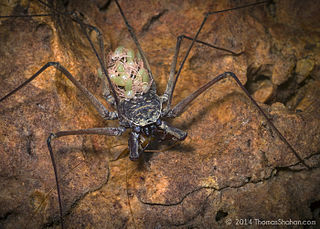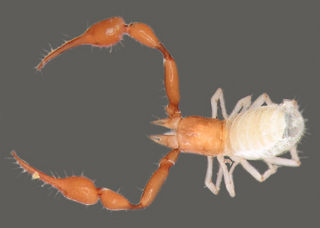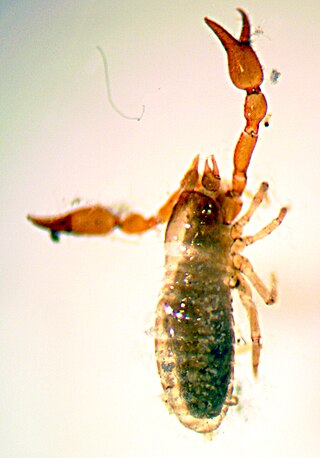
Amblypygi is an order of arachnid chelicerate arthropods also known as whip spiders or tailless whip scorpions, not to be confused with whip scorpions or vinegaroons that belong to the related order Thelyphonida. The name "amblypygid" means "blunt tail", a reference to a lack of the flagellum that is otherwise seen in whip scorpions. Amblypygids possess no silk glands or venomous fangs. They rarely bite if threatened, but can grab fingers with their pedipalps, resulting in thorn-like puncture injuries.

Uropygi is an arachnid order comprising invertebrates commonly known as whip scorpions or vinegaroons. They are often called uropygids. The name "whip scorpion" refers to their resemblance to true scorpions and possession of a whiplike tail, and "vinegaroon" refers to their ability when attacked to discharge an offensive, vinegar-smelling liquid, which contains acetic acid. The order may also be called Thelyphonida. Both names, Uropygi and Thelyphonida, may be used either in a narrow sense for the order of whip scorpions, or in a broad sense which includes the order Schizomida.
Anaulacodithella is a genus of pseudoscorpions in the family Chthoniidae. It has about seven described species.
Dithella is a genus of pseudoscorpions in the family Chthoniidae. There are at least two described species in Dithella.
Neoditha is a genus of pseudoscorpions in the family Chthoniidae. There is at least one described species in Neoditha, N. irusanga.
Sororoditha is a genus of pseudoscorpions in the family Chthoniidae. There is at least one described species in Sororoditha, S. hirsuta.
Tridenchthonius is a genus of pseudoscorpions in the family Chthoniidae. There are about 16 described species in Tridenchthonius.
Verrucaditha is a monotypic genus of pseudoscorpions in the family Chthoniidae. Its sole described species is Verrucaditha spinosa.
Verrucadithella is a genus of pseudoscorpions in the family Chthoniidae. There are at least three described species in Verrucadithella.

Damon is a genus of whip spiders, also known as tailless whip scorpions (Amblypygi) of the family Phrynichidae.

Phrynus is a genus of whip spiders found in tropical and subtropical regions, mostly in the new world.

Phrynidae is a family of amblypygid arachnida arthropods also known as whip spiders and tailless whip scorpions. Phrynidae species are found in tropical and subtropical regions in North and South America. Some species are subterranean; all are nocturnal. At least some species of Phrynidae hold territories that they defend from other individuals.

Phrynichidae is a family of arachnids.

Garypus is a genus of pseudoscorpions in the family Garypidae. It was described by German arachnologist Ludwig Carl Christian Koch in 1873. The species are found mainly in tropical and subtropical areas, where they occupy supralittoral and littoral zones in seashore habitats.

Syarinidae is a family of pseudoscorpions in the order Pseudoscorpiones. There are at least 20 genera and 110 described species in Syarinidae.
Horribates bantai is a species of windscorpion in the family Eremobatidae.
Horribates is a genus of eremobatid camel spiders, first described by Martin Hammond Muma in 1962.

Microbisium parvulum is a species of pseudoscorpion in the family Neobisiidae.

Microbisium is a genus of pseudoscorpions in the family Neobisiidae. There are about 12 described species in Microbisium.







